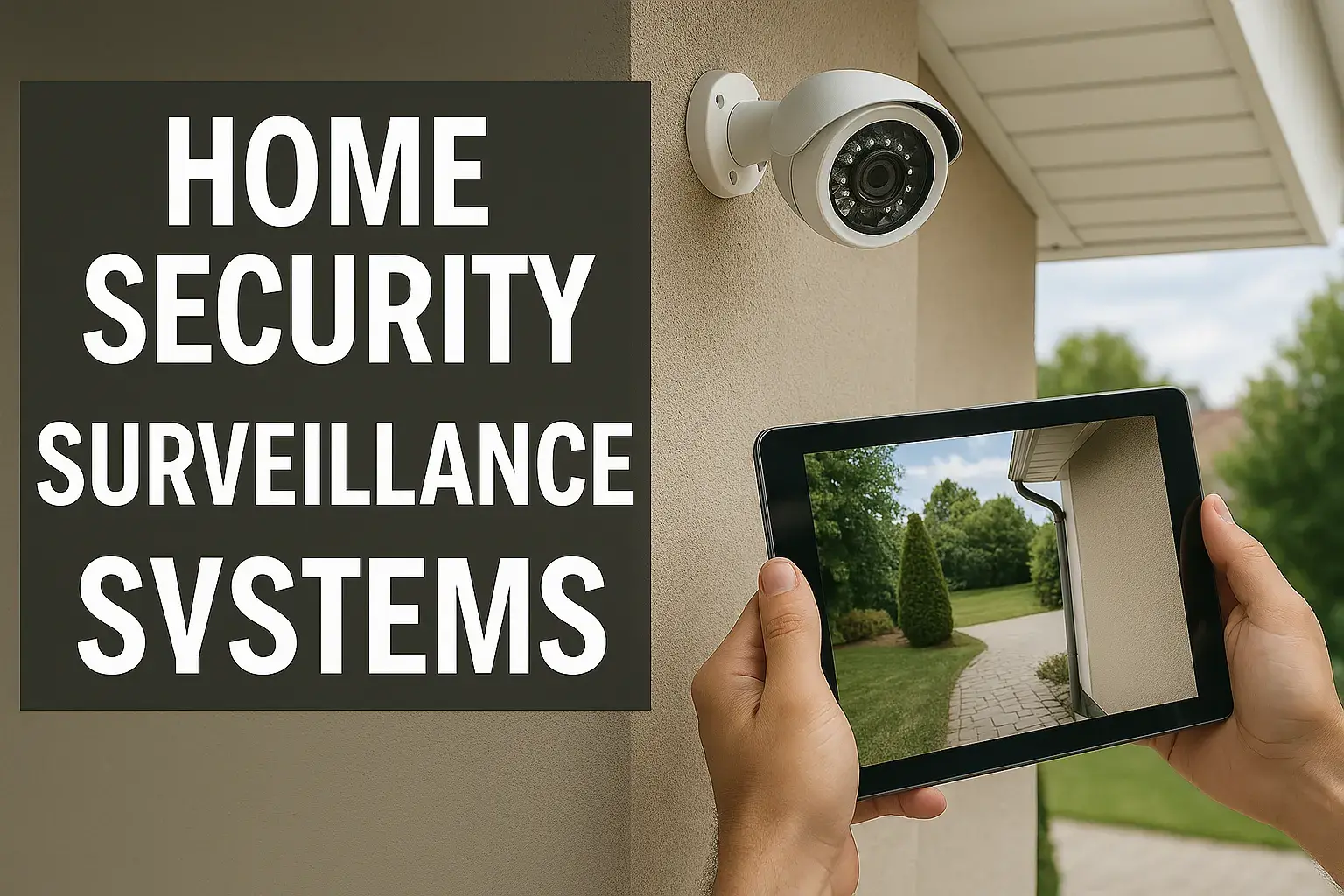
In 2025, home security surveillance systems have transformed from basic cameras to sophisticated, AI-driven solutions that integrate seamlessly with smart homes. With over 50% of U.S. households using at least one security camera, these systems are more popular than ever, driven by rising concerns about property crime and advancements in technology. This comprehensive guide explores the latest trends, top brands, essential features, and practical considerations for choosing a home security surveillance system, helping you protect your home with confidence.
The Importance of Home Security Surveillance
Home security surveillance systems are a critical component of modern home safety, offering real-time monitoring, crime deterrence, and peace of mind. According to SafeHome.org, 94 million U.S. households use security systems in 2025, with cameras being the most popular feature. These systems not only help prevent break-ins but also allow you to monitor deliveries, check on pets, or detect environmental hazards like smoke or water leaks. However, with advanced features come complexities, including cybersecurity risks and varying costs, making it essential to understand what’s available.
Key Trends in Home Security Surveillance
The landscape of home security surveillance in 2025 is shaped by cutting-edge technologies. Here are the top trends driving the industry, based on insights from sources like Reolink, Guardian Protection, and Custom Home Group:
-
Smart Home Integration: Systems now sync with devices like Amazon Alexa, Google Home, and Apple HomeKit, allowing you to control cameras, locks, and lights through a single app or voice commands. For example, you can arm your system or view camera feeds on a smart display.
-
AI and Machine Learning: AI-powered cameras use facial recognition, behavior analysis, and object detection to distinguish between people, pets, and vehicles, reducing false alarms. Some systems, like those from Guardian Protection, offer “familiar vehicle” detection to alert you only to unknown cars.
-
Video Surveillance Advancements: High-resolution cameras (up to 4K or 8K) and video doorbells with features like package detection are increasingly popular. Over 50% of U.S. homes have at least one camera, per SafeHome.org, with video doorbells leading the trend.
-
Voice Control: Integration with voice assistants enables hands-free operation, such as arming systems or checking feeds using Alexa or Google Assistant.
-
Biometric Access Controls: Facial recognition, fingerprint scanning, and iris detection provide secure, keyless entry, ideal for high-security needs.
-
Drone Surveillance: Drones equipped with cameras offer aerial monitoring for larger properties, covering blind spots and providing real-time alerts.
-
Environmental Monitoring: Sensors detect smoke, carbon monoxide, or water leaks, adding safety beyond theft prevention.
-
Cybersecurity: With increased connectivity, systems emphasize encryption, multi-factor authentication, and regular software updates to protect against hacking.
-
Eco-Friendly Options: Solar-powered cameras and energy-efficient devices reduce environmental impact and operational costs.
-
DIY vs. Professional Installation: DIY systems are affordable and flexible, while professional setups offer robust equipment and monitoring.
-
Cloud-Based vs. Local Storage: Cloud storage provides remote access but requires subscriptions, while local storage (e.g., SD cards) offers privacy without ongoing fees.
-
Professional Monitoring: Services like ADT provide 24/7 monitoring, dispatching emergency services when needed, ideal for frequent travelers or high-risk areas.
|
Trend |
Key Features |
Benefits |
Challenges |
|---|---|---|---|
|
Smart Home Integration |
App/voice control, automation |
Seamless control, convenience |
Requires compatible devices |
|
AI and Machine Learning |
Facial recognition, object detection |
Fewer false alarms, smarter alerts |
Privacy concerns, cost |
|
Video Surveillance |
4K/8K resolution, package detection |
Clear footage, real-time monitoring |
Higher cost for advanced features |
|
Voice Control |
Hands-free operation |
Ease of use |
Limited to compatible assistants |
|
Biometric Access |
Fingerprint, facial recognition |
High security, keyless entry |
Expensive, privacy issues |
|
Drone Surveillance |
Aerial monitoring, real-time alerts |
Covers large areas |
High cost, regulatory concerns |
|
Environmental Monitoring |
Smoke, CO, water leak detection |
Added safety |
Additional sensors increase cost |
|
Cybersecurity |
Encryption, multi-factor authentication |
Data protection |
Requires regular updates |
|
Eco-Friendly Options |
Solar-powered cameras |
Cost savings, sustainability |
Limited to sunny regions |
|
DIY Installation |
Easy setup, affordable |
Cost-effective, flexible |
May lack professional expertise |
|
Cloud vs. Local Storage |
Remote access vs. privacy |
Flexibility vs. no fees |
Subscriptions vs. manual management |
|
Professional Monitoring |
24/7 emergency response |
Peace of mind |
Monthly fees, contracts |
Types of Home Security Surveillance Systems
Home security surveillance systems come in various forms, each suited to different needs:
-
Indoor Cameras: Monitor living spaces, hallways, or valuables. Ideal for checking on pets or children.
-
Outdoor Cameras: Weather-resistant, designed for driveways, yards, or entry points. Often include night vision.
-
Video Doorbells: Combine doorbell functionality with cameras, offering two-way audio and visitor monitoring.
-
Wireless vs. Wired Systems: Wireless systems are easy to install and flexible, while wired systems offer reliable connections.
-
All-in-One Hubs: Integrate cameras, alarms, and sensors into a single system for comprehensive security.
Top Brands and Products in 2025
Several brands lead the market, offering a range of options for different budgets and needs:
-
Ring:
-
Products: Ring Video Doorbell Pro 2 (3D motion detection, pre-roll video), Ring Stick Up Cam (indoor/outdoor).
-
Strengths: Affordable, Alexa integration, easy DIY setup.
-
Price: Starts at $200, with monitoring at $10/month.
-
Source: CNET (https://www.cnet.com/home/security/best-home-security-system/).
-
-
Arlo:
-
Products: Arlo Ultra 2 (4K, color night vision), Arlo Pro 5S (wireless, wide field of view).
-
Strengths: High-quality video, long battery life, AI features.
-
Price: Starts at $400, cloud storage from $8/month.
-
-
Nest (Google):
-
Products: Nest Cam Indoor (1080p, activity zones), Nest Cam Outdoor (battery-powered, weather-resistant).
-
Strengths: Excellent video, Google Assistant integration.
-
Price: Starts at $300, subscriptions from $6/month.
-
-
Wyze:
-
Products: Wyze Cam v3 (1080p, color night vision), Wyze Cam Floodlight (motion-activated).
-
Strengths: Budget-friendly, free cloud storage options.
-
Price: Starts at $100, subscriptions optional.
-
-
SimpliSafe:
-
Products: SimpliCam (1080p, two-way audio), Outdoor Camera (spotlight, weather-resistant).
-
Strengths: Comprehensive packages, no contracts.
-
Price: Starts at $250, monitoring from $20/month.
-
-
ADT:
-
Products: ADT Video Doorbell, Indoor/Outdoor Cameras.
-
Strengths: Professional monitoring, reliable for large homes.
-
Price: $500–$1,500 upfront, $30–$50/month.
-
|
Brand |
Key Product |
Resolution |
Key Features |
Price Range |
|---|---|---|---|---|
|
Ring |
Video Doorbell Pro 2 |
1080p |
3D motion, Alexa integration |
$200–$300 |
|
Arlo |
Ultra 2 |
4K |
Color night vision, AI detection |
$400–$600 |
|
Nest |
Cam Indoor |
1080p |
Activity zones, Google Assistant |
$300–$400 |
|
Wyze |
Cam v3 |
1080p |
Color night vision, free storage |
$100–$200 |
|
SimpliSafe |
SimpliCam |
1080p |
Two-way audio, no contracts |
$250–$400 |
|
ADT |
Video Doorbell |
1080p |
Professional monitoring |
$500–$1,500 |
Choosing the Right System
Selecting the right system depends on several factors:
-
Home Size and Layout: Larger homes need more cameras and sensors. Multi-story homes may require Wi-Fi extenders.
-
Budget: DIY systems like Wyze are cost-effective, while professional systems like ADT are pricier but comprehensive.
-
Specific Needs: Pet owners need AI-driven pet-friendly sensors. Frequent travelers benefit from professional monitoring.
-
Smart Home Compatibility: Ensure the system works with your existing devices (e.g., Alexa, Google Home).
-
Scalability: Choose systems that allow adding more cameras or sensors later.
Installation and Setup
-
DIY vs. Professional: DIY systems are plug-and-play, often installed in under an hour. Professional installation ensures optimal placement but costs more.
-
Camera Placement: Position cameras at entry points, driveways, and high-traffic areas. Ensure outdoor cameras are weather-resistant.
-
Mobile Apps: Most systems offer apps for remote monitoring, arming/disarming, and receiving alerts. Test connectivity during setup.
Privacy and Legal Considerations
Privacy is a significant concern with connected cameras. To protect your data:
-
Use strong, unique passwords and enable two-factor authentication.
-
Choose systems with end-to-end encryption.
-
Opt for local storage if privacy is a priority.
-
Check local laws on recording, especially for audio or public-facing cameras, to avoid legal issues.
Cost Analysis
-
Initial Costs: DIY systems start at $100–$500, while professional setups range from $500–$2,000.
-
Subscription Fees: Cloud storage costs $5–$20/month, professional monitoring $20–$50/month.
-
Maintenance: Battery replacements or upgrades may cost $50–$100 annually.
-
Savings: Many insurance providers offer 5–20% discounts for homes with security systems.
FAQs
-
What are the benefits of AI in home security surveillance?
-
AI reduces false alarms by distinguishing between people, pets, and vehicles, and offers features like facial recognition for smarter alerts.
-
-
How do I choose between DIY and professionally installed systems?
-
DIY systems are affordable and flexible, ideal for tech-savvy users. Professional systems offer robust equipment and 24/7 monitoring, better for complex setups.
-
-
What should I consider when selecting a surveillance camera?
-
Look for high resolution (1080p or 4K), night vision, weather resistance, and smart home compatibility.
-
-
Are there privacy concerns with smart surveillance systems?
-
Yes, connected devices can be hacked if not secured. Use encryption, strong passwords, and check the company’s data policies.
-
-
How can I ensure my system is cybersecure?
-
Choose reputable brands, enable two-factor authentication, update firmware regularly, and consider local storage.
-
-
What are the latest camera advancements in 2025?
-
Advancements include 8K resolution, improved low-light performance, AI-driven analytics, and better smart home integration.
-
-
Can I expand my system later?
-
Most systems are scalable, allowing additional cameras or sensors. Check compatibility before purchasing.
-
-
Do I need a subscription?
-
Subscriptions are often required for cloud storage or advanced features, but local storage systems may not need them.
-
Conclusion
Home security surveillance systems in 2025 offer unparalleled protection through advanced technologies like AI, smart home integration, and drone surveillance. By understanding the latest trends, top brands, and key considerations, you can choose a system that fits your needs and budget. Whether you opt for a budget-friendly DIY setup or a comprehensive professional system, investing in surveillance enhances safety and peace of mind. Stay informed, prioritize cybersecurity, and protect your home with confidence.



